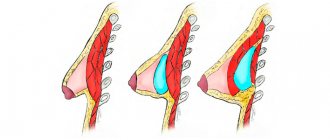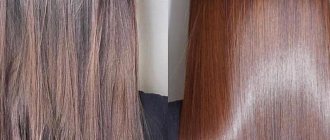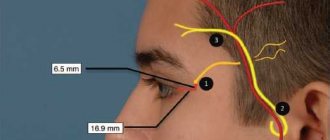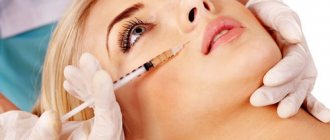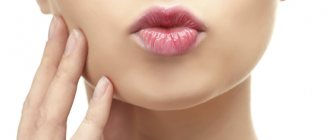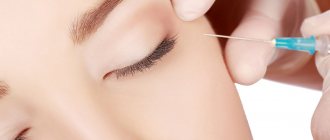If this article stops at least one woman from smoothing out wrinkles with Botox, it was not written in vain.
The trouble is that the information field is clogged with one-sided concepts about Botox, generated by the cosmetology industry with one sole purpose - obtaining financial gain. But no attempts to create the appearance of the benefits of Botox can refute the fact that it is the most terrible poison of neuroparalytic action. All this diminutive rhetoric about “micro”, “baby”, “nano” doses is just a commercial ploy. Botox is definitely harmful, period. In any doses. This is a powerful poison that paralyzes nerve impulses and “turns off” muscles, giving ugly complications, and also insidiously penetrates into other parts of the body, beyond the injection area.
Before you inject yourself in the face with a substance, one gram of which kills a million people, let’s look at the facts and scientific evidence. We think and draw conclusions about how dangerous Botox is.
The quality of life
Due to advances in detection and treatment, about 70% of cancer patients live more than five years after diagnosis (in the USA); in Russia, similar statistics are generally somewhat worse, but vary depending on the diagnosis. With timely diagnosis and treatment of breast cancer, for example, the survival rate is 80–90%.
Research (Carver, Ganz, Gotay)
show that appearance concerns are a major concern among cancer survivors, affecting their quality of life in the physical, emotional, social, and sexual domains.
People who have overcome cancer consider financial problems and appearance problems to be the main ones.
Demand for facial rejuvenation procedures requiring injections is gradually increasing due to safe and effective results. Of these, botulinum toxins and hyaluronic acid fillers are most often used, either alone or in combination. Moreover, the demand for such procedures is high both in groups that received similar procedures before treatment, and among those who did not undergo such procedures (Carruthers 2003)
.
Scientific publications indicate that facial rejuvenation leads to a significant increase in self-esteem and quality of life components in healthy and conditionally healthy patients. In addition, facial rejuvenation may improve physical health, mood, lifestyle, overall life satisfaction, appearance, self-awareness, perception of one's intelligence, weight, attractiveness, sense of accomplishment, external self-esteem, social self-esteem, and performance-related self-esteem (Dayan, Arkins )
.
What objective reasons can be considered indications for correction?
At a young age, patients most often resort to correction in order to delay the appearance of wrinkles (to minimize their appearance in older age) or to remove existing wrinkles.
With constant intense muscle contractions of the facial muscles, dynamic wrinkles can form even at a young age. Subsequently, atrophy of the skin and subcutaneous structures occurs, and static wrinkles are formed, which will become more and more pronounced with age.
In such a situation, the administration of small doses of neuroprotein blocks the release of acetylcholine into the neuromuscular junction and causes temporary chemical denervation of the overactive muscle, smoothes the skin and prevents its atrophy.
The first wrinkles most often appear in the upper third of the face (between the eyebrows, crow's feet, forehead). For some, they may appear after the age of 30, while others begin to notice them at 18.
There may be several reasons for the appearance of the first wrinkles at a young age:
- increased emotionality combined with active facial expressions (hyperkinetic type);
- fine-wrinkled type of aging;
- headache;
- voltage.
These reasons should be indications for early correction and the method of choice for young patients. After all, you can stop the hyperkinetic activity of muscles, which leads to the formation of dynamic wrinkles, only with botulinum therapy, and a pleasant addition will be the formation of the habit of correctly expressing emotions, because living without wrinkles is more fun than with them. Moreover, there is research that botulinum toxin can help patients cope with depression. According to scientists, paralysis of the muscles that are usually responsible for a dissatisfied, frowning appearance leads to a decrease in negative emotions. Consequently, a negative mood is more difficult to maintain, and thus the person experiences more positive emotions.
Pro et Contra. Prevention of aging or fashion trend?
Several years ago, an article was published in a well-known fashion magazine in which young patients “in their early 20s” were encouraged to start taking botulinum toxin injections at such a young age.
The article at that time literally blew up the Internet and the medical community and, to some extent, contributed to the growing popularity of “beauty injections” among young patients. Now the topic raised in the article still remains relevant. And if fashion magazines unanimously shout that botulinum toxin can be used at any age and by everyone without exception, in the scientific community the attitude towards botulinum therapy is more restrained. We will discuss this topic again, and we will touch upon not only the medical validity of early correction, but also the moral and philosophical side of the issue.
Why is Botox harmful?
If you are still not sure whether to inject a biological weapon into your face or not, let's move on to the main argument. Let's figure out exactly how facial wrinkles disappear due to Botox injections (small doses of poison). The neurotoxin blocks acetylcholines, which are transmitters of nervous excitation. Nerve impulses are paralyzed and signal transmission from nerve to muscle stops. That's it: the muscle no longer performs its function, it relaxes and does not contract.
Botox causes irreparable harm to health and beauty. And no benefit, except for a short-term and controversial aesthetic effect. Yes, wrinkles in the Botox injection area will smooth out for a few months, but at what cost! Muscle paralysis is not even a side effect, but the mechanism of action of the poison itself. And the side effects of Botox with such a “barbaric” approach to beauty are completely demonic (details in the next chapter).
Do not believe that doses of poison can be safe. No matter how “nano” they are, they block muscle function in any case. And then the replacement mechanism turns on: if some muscles do not function, neighboring muscles will work for them, that is, work for themselves and also for those immobilized, saturated with poison.
And this is where real aging begins, in earnest, and an accelerated process. The muscles that worked for their paralyzed neighbors become overstrained, and the vectors of skin tension change. A lot of new wrinkles, creases, and bumps appear on the face. Oh God! They weren't there a week ago? Where did you come from? From one small and insidious prick, which gave the illusion of youth for several months, but in fact, stole beauty.
The hard truth is that Botox accelerates age-related changes, not prevents them.
The technique has the following contraindications:
— Patient hypersensitivity to the components of the drug used.
- Myasthenia gravis, myasthenic syndrome and myasthenic-like syndrome (including Lambert-Eaton syndrome).
— Diseases with blood clotting disorders.
— Compounded allergy history.
- Any acute infectious diseases.
— Pregnancy, lactation.
- Taking antiplatelet agents, anticoagulants, antibiotics or muscle relaxants.
— Unstable mental state of the patient.
- Alcohol abuse.
How is the procedure done?
Before starting the procedure, the dermatocosmetologist examines the client’s health status, warns him about the possible consequences of the procedure and undesirable effects. Then informed consent is drawn up, and photo documentation is taken to fill out the patient’s medical record.
The doctor examines the patient's face in an upright position. The facial muscles are worked on, the cosmetologist determines the injection sites and calculates the amount of the drug at each injection point.
Makeup is first removed, the injection site is treated with an antiseptic, and manipulation is performed on the selected areas. The duration of this procedure is up to 30 minutes.
Consequences of Botox injections
Beauty, of course, is a terrible force. You can't argue with a classic here. But in the case of Botox, beauty is also a scary sight. Side effects from Botox injections are not exceptions to the rules, but patterns. And they are ugly:
- Slipping and sagging of atrophied forehead muscles (ptosis). Immobilized and helpless forehead muscles literally crawl into the eyes. The eyelids and eyebrows are pulled down, creating the “Viya look.” Do you remember Gogol’s mystical story and the most famous quote from it: “Lift my eyelids”?
- Ugly bumps above the eyebrows (“Mephistopheles forehead”).
- Naughty facial expressions. Instead of a relevant expression of emotions, there are terrible grimaces that have nothing to do with them.
- Facial asymmetry.
- Closed or half-closed eye. Due to migration outside the injection area, the drug paralyzes neighboring muscles.
- Crooked mouth. One corner of the mouth droops when speaking, smiling, or simply statically. It is impossible to move your lips.
- Hoarse voice.
- Eyelid hernias and swelling.
And these are just the most common external manifestations of the harm that Botox causes. But the problem is deeper, it concerns health. About half of women who get Botox experience headaches and migraines. What did you want? This is a toxin, and the blood vessels suffer from it.
Other health complications from Botox injections:
- osteoporosis of the skull,
- disturbances in the functioning of the cranial nerves,
- skeletal muscle dysfunction,
- disturbance in the functioning of the nerve centers of the heart,
- speech disorder,
- swallowing disorder
- strabismus,
- mydriasis (pupil dilation),
- anisocoria of the pupils (different sizes),
- blindness.
And dozens more dysfunctions.
Who should be called a young patient?
In the time of Hippocrates, the 40th birthday was considered a transitional age - from a young man to an old man.
Times are changing, and currently 40–60 years are the age of maturity, social activity and success.
Age classification offered by the World Health Organization:
- from 25 to 44 years old – young age;
- from 45 to 60 years – middle age;
- from 60 to 70 years – old age;
- from 75 to 90 years – old age;
- over 90 years old are long-livers.
So how do we determine age? According to your passport? According to the biological state of the body? By state of mind?
It is impossible to answer these questions unambiguously. Everyone formulates their own concept of age and individually feels the moment of old age. A person, especially a woman, does not always perceive in the same way how he feels and how he looks and likes himself in the mirror. Few people will like the compliment “You look your age.” Most women prefer to look younger, and therefore even very young patients, succumbing to the temptation of glossy magazines and Photoshop, want to resort to botulinum toxin injections at a young age (up to 30 years).
Let's see what opinion there is on this matter in professional scientific circles.
At the moment, botulinum therapy is one of the most popular and effective non-surgical rejuvenation methods and is among the TOP most used in the world.
In the United States, more than 2 million injections were reported in 2003, just one year after botulinum toxin received FDA approval for glabellar lines (Batra et al., 2005).
According to surveys by the American Society of Aesthetic Plastic Surgery (ASAPS), approximately 4.3 million botulinum toxin correction procedures were performed in 2015, accounting for 42% of all cosmetic procedures.
However, the survey clarified that patients' satisfaction with their appearance increased by 28% when they received injections in the so-called zone 11s (glabellar wrinkles that appear between the eyebrows with age).
Dr. Daniel S. Mills, President of ASAPS states, “The results of this study are not unexpected and confirm what we have suspected for a long time. I am seeing an increasing number of patients ranging in age from 20 to 70 years old at my clinic in Laguna Beach, California, who are requesting botulinum toxin type A injections between the eyebrows and other areas of the face (crow's feet, forehead) as a preventative measure against aging. It is a quick, non-surgical remedy, and this new study confirms the effectiveness of botulinum toxin type A in meeting patient expectations.”
And it's easy to explain: unlike other products used for cosmetic procedures, BTX-A correction is minimally invasive, relatively easy, has almost immediate and visible effects and a fast recovery period, and is often more affordable than other cosmetic procedures (Klein 2004 ).
However, botulinum toxin injections at 20 and 60 years old differ both in indications and in the protocol for performing the procedure.
It is interesting to note that there are relatively few scientific articles devoted to the correction of young patients. Despite the calls of the fashion industry, which is in constant pursuit of youth and beauty, ideal candidates for BTA injections from a medical point of view are still men and women aged 40 to 60 years, whose facial wrinkles have formed due to repeated muscle contractions in over time (Allergan PI 2005).
What can force a young patient to resort to correction is not a real wrinkle, but only its appearance.
And here it is very important for the doctor to rely not on the subjective opinion of an individual patient or his own, but only on an objective picture. And in especially severe cases, it is possible to send the patient to a psychotherapist.
Back in 2010, scientists noted an increase in dysmorphophobia among patients. Now this mental disorder has worsened and is causing widespread concern.
Recent surveys show that among patients who wish to undergo cosmetic surgery and other types of correction, from 5 to 15% suffer from body dysmorphic disorder (BDD). Retrospective studies suggest that people with BDD rarely experience improvement in symptoms after treatment, leading some scientists to suggest that BDD is a contraindication to such treatment.
“Modern society is characterized by the desire to achieve and maintain a youthful appearance, and men and women are increasingly seeking reasons for cosmetic intervention. Corrective dermatological procedures are one area associated with such clients. Corrective treatments include chemical peels, fillers, botulinum toxin, laser treatments, mesotherapy, etc. Although clients are generally satisfied with the results of these minimally invasive cosmetic procedures, there are some people who have unrealistic outcome expectations. In addition, there is a certain subgroup of people who are never satisfied with the result. They tend to have a mental disorder known as body dysmorphic disorder. The main challenge for the clinician in this case is to detect clients with such unrealistic expectations. Health care professionals who perform corrective procedures must take their clients seriously...” is the slogan used by practitioners and physicians to address this serious issue.
In 2016, evidence emerged in professional journals that young adults, especially women, were increasingly tempted to resort to plastic surgery and aesthetic procedures. Thus, a survey conducted by Wixted & Co showed that women are more willing to undergo plastic surgery: 42% of women versus 22% of men. Nearly half of adults aged 25-34 will have cosmetic surgery, compared with 26% of people 55 and older.
The authoritative American journal on plastic surgery, JAMA Facial Plastic Surgery, published data that facial defects were associated with a significant decrease in the quality of life of patients, and surgical correction of defects was perceived by them as an intervention with a high degree of expectation.
The researchers conducted a randomized analysis of 200 socioeconomically diverse patients (79% women, mean age 32 years) who viewed images of individuals with defects before and after surgical correction. They were asked to rate the possible health benefits and willingness to pay for the procedures performed. They perceived minor facial defects less dramatically, in contrast to extensive and pronounced defects.
Recommendations after the procedure
After completing the botulinum toxin injection, the patient must follow simple rules:
— It is recommended to maintain an upright position for four hours after the procedure.
— For the next 24 hours, it is forbidden to touch or massage the injection areas.
— For four hours, you need to make active movements with your facial muscles.
— In the next 2 weeks, you should refrain from facial massage.
- Do not drink strong alcoholic drinks during the day.
— It is prohibited to visit saunas and solariums, and to engage in intense sports for 7 days.
